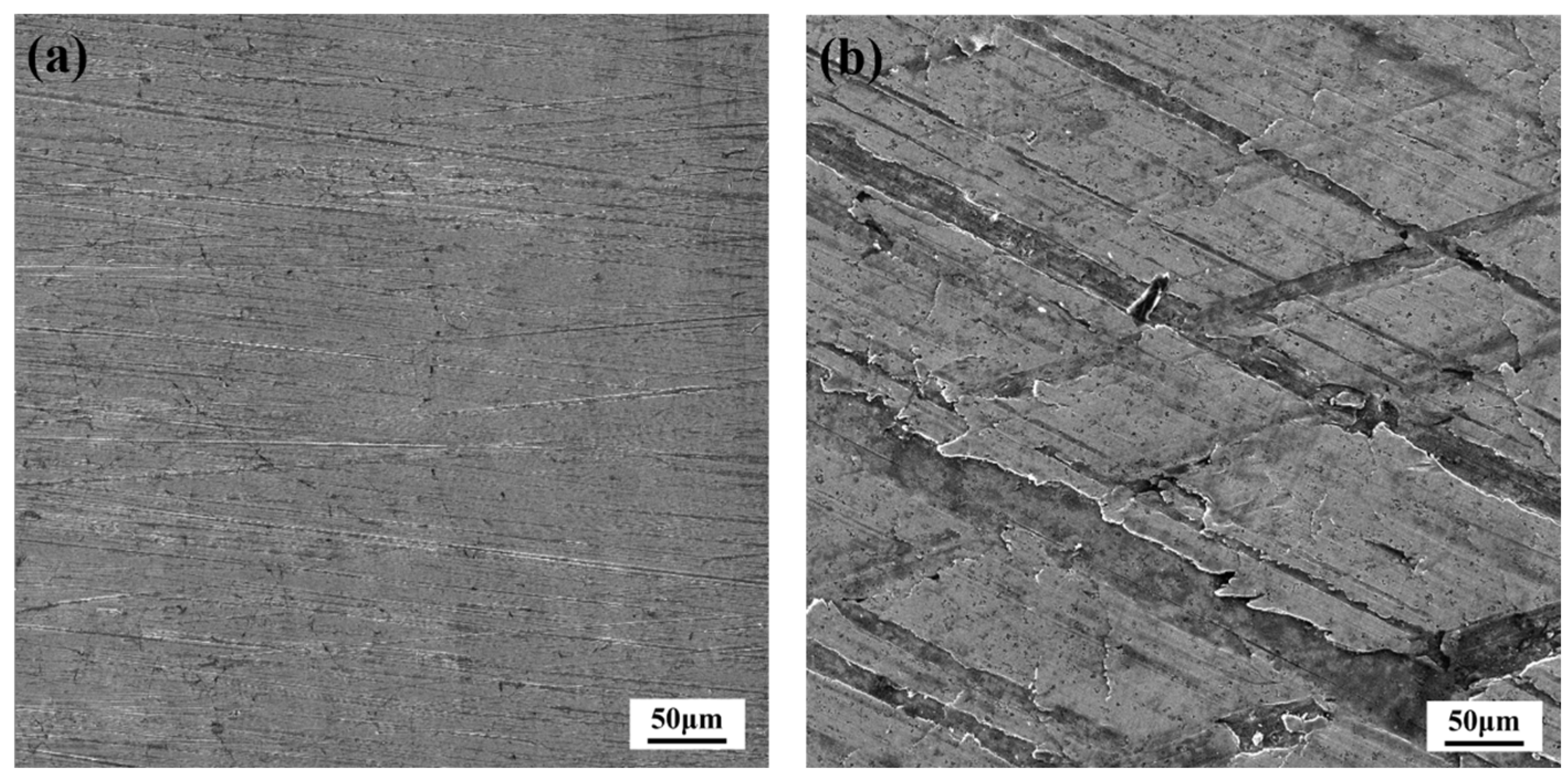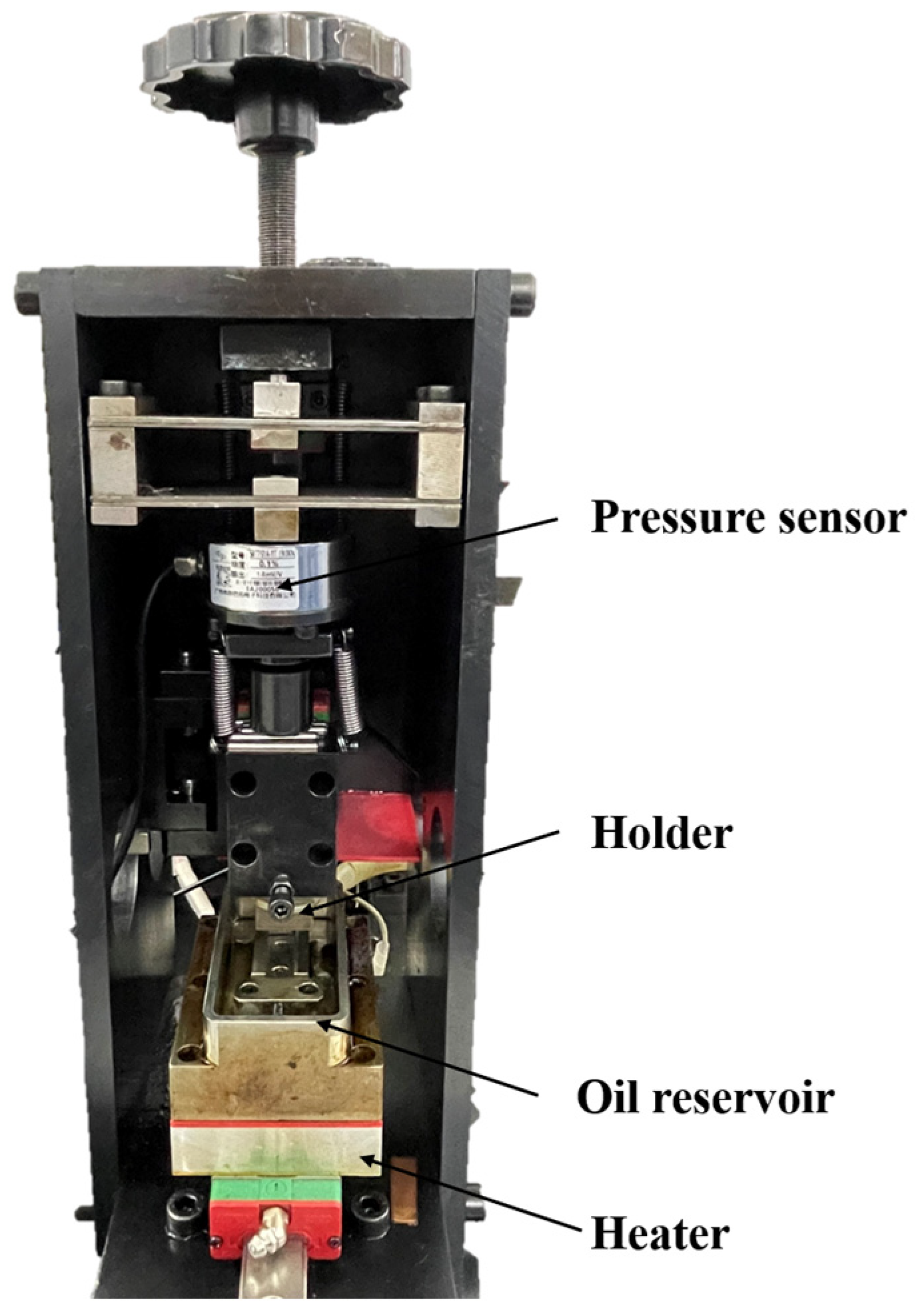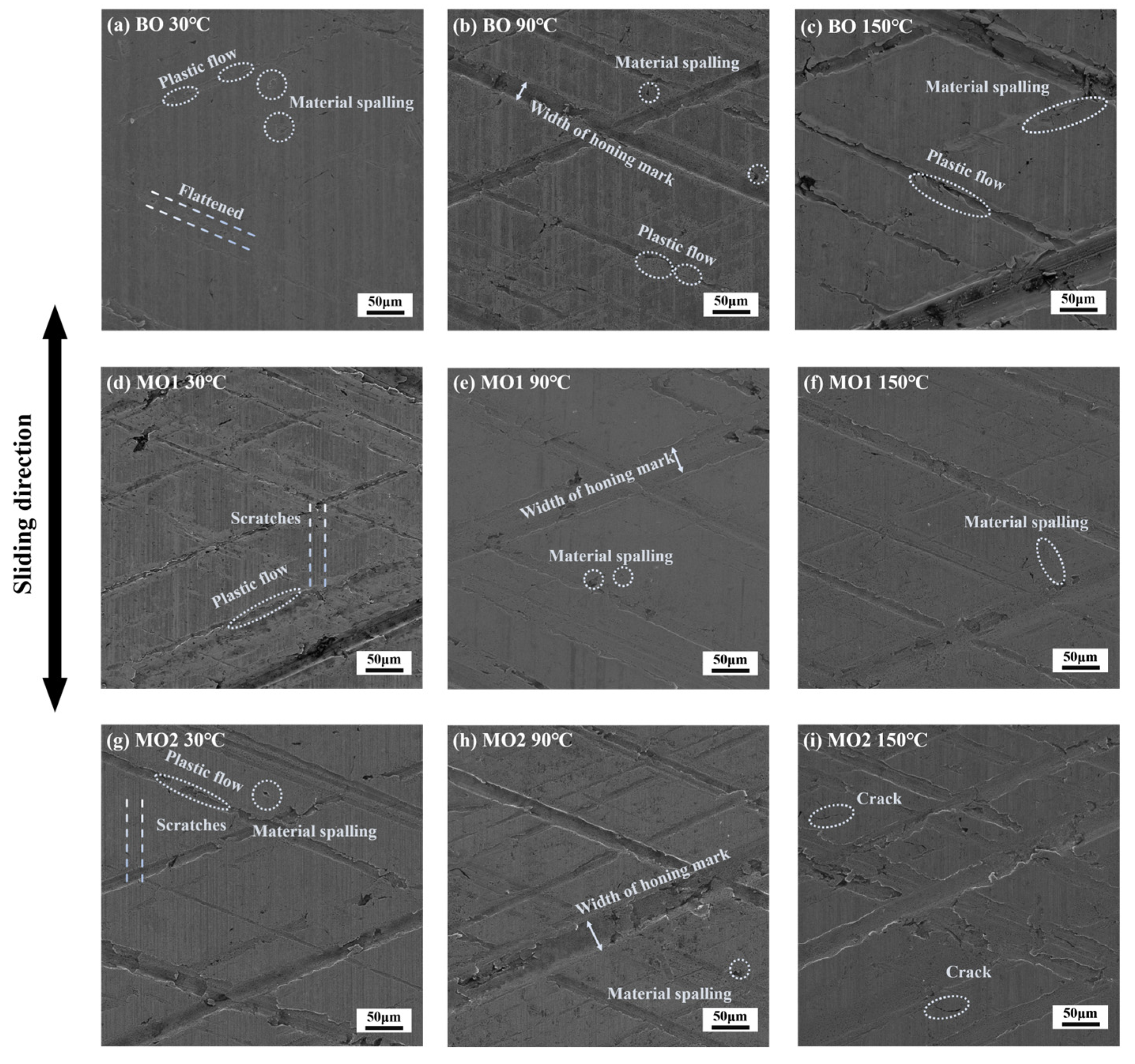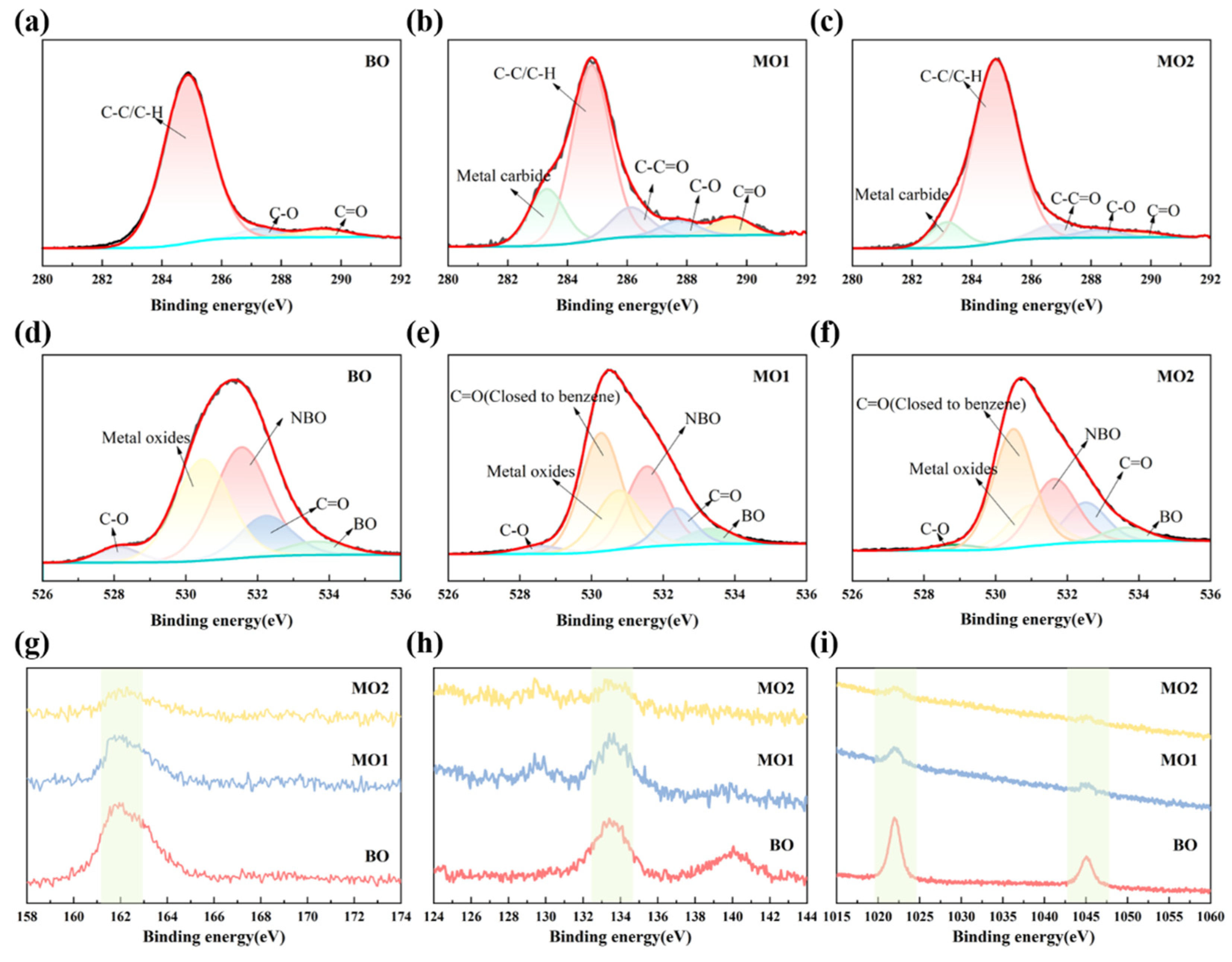Investigation of 1,3-Diketone and Nano-Copper Additives for Enhancing Boundary Lubrication Performance
Abstract
1. Introduction
2. Materials and Methods
2.1. Materials
2.2. Friction and Wear Test
2.3. Characterization
3. Results and Discussion
3.1. Friction and Wear Tests
3.2. Morphology Analysis of Worn Surfaces
3.3. XPS Analysis of Worn Surfaces
3.4. Lubrication Effect of 1,3-Diketone and Nano-Copper Particles
4. Conclusions
Author Contributions
Funding
Data Availability Statement
Acknowledgments
Conflicts of Interest
References
- Chen, S.; Miao, C.; Zhang, Q. Understanding the Evolution of China’s Green Shipping Policies: Evidence by Social Network Analysis. J. Clean. Prod. 2024, 482, 144204. [Google Scholar] [CrossRef]
- Purayil, S.T.P.; Hamdan, M.O.; Al-Omari, S.A.B.; Selim, M.Y.E.; Elnajjar, E. Review of Hydrogen–Gasoline SI Dual Fuel Engines: Engine Performance and Emission. Energy Rep. 2023, 9, 4547–4573. [Google Scholar] [CrossRef]
- Pham, Q.; Park, S.; Agarwal, A.K.; Park, S. Review of Dual-Fuel Combustion in the Compression-Ignition Engine: Spray, Combustion, and Emission. Energy 2022, 250, 123778. [Google Scholar] [CrossRef]
- Gültekin, N.; Ciniviz, M. Examination of the Effect of Combustion Chamber Geometry and Mixing Ratio on Engine Performance and Emissions in a Hydrogen-Diesel Dual-Fuel Compression-Ignition Engine. Int. J. Hydrogen Energy 2023, 48, 2801–2820. [Google Scholar] [CrossRef]
- Wang, J.; Teng, D.; Zhang, Y.; Sa, X.; Li, C.; Cui, Q.; Fan, J. Research on Friction and Wear Behaviors of Different Solid Lubricant Coatings on Aluminum-Based Piston Skirts. J. Tribol. 2024, 146, 081401. [Google Scholar] [CrossRef]
- Wang, X.; Zhao, Y.; Dai, B.; Sun, Q.; Wang, X.; Lou, W.; Yang, J. Tribological Performance of Recyclable Oil-Soluble Magnetic MXene as Efficient Lubricant Additives under Boundary Lubrication Conditions. Tribol. Int. 2025, 204, 110427. [Google Scholar] [CrossRef]
- Fan, J.; Shen, Y.; Liu, Y.; Qu, J.; Liu, J.; Yu, B.; Xu, J. Improved Friction and Wear Performance Utilized with Aminoguanidine-Based Ionic Liquid over Wide Temperature Range for Reciprocating Frictional Contact Surface. Tribol. Lett. 2025, 73, 39. [Google Scholar] [CrossRef]
- Amann, T.; Kailer, A. Analysis of the Ultralow Friction Behavior of a Mesogenic Fluid in a Reciprocating Contact. Wear 2011, 271, 1701–1706. [Google Scholar] [CrossRef]
- Amann, T.; Kailer, A. Ultralow Friction of Mesogenic Fluid Mixtures in Tribological Reciprocating Systems. Tribol. Lett. 2010, 37, 343–352. [Google Scholar] [CrossRef]
- Li, K.; Amann, T.; Walter, M.; Moseler, M.; Kailer, A.; Rühe, J. Ultralow Friction Induced by Tribochemical Reactions: A Novel Mechanism of Lubrication on Steel Surfaces. Langmuir 2013, 29, 5207–5213. [Google Scholar] [CrossRef]
- Li, K.; Zhang, S.; Liu, D.; Amann, T.; Zhang, C.; Yuan, C.; Luo, J. Superlubricity of 1,3-Diketone Based on Autonomous Viscosity Control at Various Velocities. Tribol. Int. 2018, 126, 127–132. [Google Scholar] [CrossRef]
- Yuan, Y.; Amann, T.; Xu, Y.; Zhang, Y.; Chen, J.; Yuan, C.; Li, K. Load and Velocity Boundaries of Oil-Based Superlubricity Using 1,3-Diketone. Friction 2023, 11, 704–715. [Google Scholar] [CrossRef]
- Li, J.; Yuan, Y.; Amann, T.; Yuan, C.; Li, K. Macroscopic Oil-Based Superlubricity Achieved on Steel Surfaces with the Roughness of Engineering Level. Tribol. Lett. 2023, 71, 32. [Google Scholar] [CrossRef]
- Cui, Y.; Guo, J.; Cheng, J.; Geng, Y.; Tan, H.; Zhu, S.; Yang, J. Methylcellulose-Functionalized Gallium-Based Liquid-Metal Nanoparticles as Water-Based Lubricant Additives. Tribol. Int. 2025, 202, 110336. [Google Scholar] [CrossRef]
- Li, K.; Yang, Y.; Amann, T.; Yuan, C. Synergistic Effect of 1,3-Diketone Fluid and Carbon-Based Nanoparticles as Hybrid Eco-Friendly Additives in Polyalphaolefin Oil. Tribol. Lett. 2023, 71, 53. [Google Scholar] [CrossRef]
- Syed, J.; Hakkim, N.L.; Nebhani, L.; Nand, N. Gosvami Enhancing Tribological Properties of Lubricated Contacts via Synergistic Interactions of Green Silica Nanoparticles and ZDDP. Tribol. Int. 2024, 197, 109829. [Google Scholar] [CrossRef]
- Yang, S.; Hua, K.; Zhang, X.; Liu, X. Enhanced Lubricating Performance by Combining Proton-Type Ionic Liquids and Water-Soluble Cu Nanoparticles as Water-Based Lubrication Additives at the Steel\Steel Interface. Colloids Surf. A. 2024, 703, 135274. [Google Scholar] [CrossRef]
- Guo, P.; Yan, Z.; Xu, J.; Shen, Y.; Wang, J. Wear Life Prediction of Piston Ring and Cylinder Liner Based on Integration of Experiment and Bench Test Data. Eng. Fail. Anal. 2024, 161, 108259. [Google Scholar] [CrossRef]
- Obert, P.; Müller, T.; Füßer, H.-J.; Bartel, D. The Influence of Oil Supply and Cylinder Liner Temperature on Friction, Wear and Scuffing Behavior of Piston Ring Cylinder Liner Contacts—A New Model Test. Tribol. Int. 2016, 94, 306–314. [Google Scholar] [CrossRef]
- Ge, C.; Zhang, B.; Xu, X.; Lyu, X.; Ma, X.; Li, T.; Lu, X.; Liu, Z. Tribofilm Distribution and Tribological Analysis of Piston Ring-Cylinder Liner Interfaces under Realistic Engine Conditions. Tribol. Int. 2025, 201, 110250. [Google Scholar] [CrossRef]
- Zhang, B.; Ma, X.; Liu, L.; Morina, A.; Lu, X. Sliding Wear Mechanisms and Speed-Load Wear Map of Cylinder Liner and Piston Ring under Lubricated Conditions. Wear 2025, 564, 205701. [Google Scholar] [CrossRef]
- Demas, N.G.; Erck, R.A.; Ajayi, O.O.; Fenske, G.R. Tribological Studies of Coated Pistons Sliding against Cylinder Liners under Laboratory Test Conditions. Lubr. Sci. 2012, 24, 216–227. [Google Scholar] [CrossRef]
- Cao, H.; Meng, Y. Electrochemical Effect on Boundary Lubrication of ZDDP Additive Blended in Propylene Carbonate / Diethyl Succinate. Tribol. Int. 2018, 126, 229–239. [Google Scholar] [CrossRef]
- Xiuyi, L.; Jiao, B.; Lu, X.; Zou, D.; Ma, X.; Neville, A. A Statistical Piston Ring Lubrication Model Considering the Tribofilm and Its Effect of Two-Stroke Marine Engines. Tribol. Int. 2023, 177, 107996. [Google Scholar] [CrossRef]
- Spikes, H. The History and Mechanisms of ZDDP. Tribol. Lett. 2004, 17, 469–489. [Google Scholar] [CrossRef]
- Du, S.; Zhang, C.; Luo, Z. The Synergistic Effect of Diketone and Its Chelate Enables Macroscale Superlubricity for a Steel/Steel Contact. Tribol. Int. 2022, 173, 107610. [Google Scholar] [CrossRef]
- Du, S.; Zhang, C.; Luo, Z. Combination of Diketone and PAO to Achieve Macroscale Oil-Based Superlubricity at Relative High Contact Pressures. Friction 2024, 12, 869–883. [Google Scholar] [CrossRef]
- Du, S.; Zhang, C.; Luo, Z. Effect of the Molecular Structure of 1,3-Diketones on the Realization of Oil-Based Superlubricity on Steel/Steel Friction Pairs. Langmuir 2023, 40, 805–817. [Google Scholar] [CrossRef]
- Massoud, T.; De Matos, R.P.; Le Mogne, T.; Belin, M.; Cobian, M.; Thiébaut, B.; Loehlé, S.; Dahlem, F.; Minfray, C. Effect of ZDDP on Lubrication Mechanisms of Linear Fatty Amines under Boundary Lubrication Conditions. Tribol. Int. 2020, 141, 105954. [Google Scholar] [CrossRef]
- Gosvami, N.N.; Bares, J.A.; Mangolini, F.; Konicek, A.R.; Yablon, D.G.; Carpick, R.W. Mechanisms of Antiwear Tribofilm Growth Revealed in Situ by Single-Asperity Sliding Contacts. Science 2015, 348, 102–106. [Google Scholar] [CrossRef]
- Guo, Z.; Zhang, Y.; Wang, J.; Gao, C.; Zhang, S.; Zhang, P.; Zhang, Z. Interactions of Cu Nanoparticles with Conventional Lubricant Additives on Tribological Performance and Some Physicochemical Properties of an Ester Base Oil. Tribol. Int. 2020, 141, 105941. [Google Scholar] [CrossRef]









Disclaimer/Publisher’s Note: The statements, opinions and data contained in all publications are solely those of the individual author(s) and contributor(s) and not of MDPI and/or the editor(s). MDPI and/or the editor(s) disclaim responsibility for any injury to people or property resulting from any ideas, methods, instructions or products referred to in the content. |
© 2025 by the authors. Licensee MDPI, Basel, Switzerland. This article is an open access article distributed under the terms and conditions of the Creative Commons Attribution (CC BY) license (https://creativecommons.org/licenses/by/4.0/).
Share and Cite
Wang, J.; Teng, D.; Fan, J.; Zhang, X.; Cui, Q.; Li, K.; Liew, P.J. Investigation of 1,3-Diketone and Nano-Copper Additives for Enhancing Boundary Lubrication Performance. J. Mar. Sci. Eng. 2025, 13, 912. https://doi.org/10.3390/jmse13050912
Wang J, Teng D, Fan J, Zhang X, Cui Q, Li K, Liew PJ. Investigation of 1,3-Diketone and Nano-Copper Additives for Enhancing Boundary Lubrication Performance. Journal of Marine Science and Engineering. 2025; 13(5):912. https://doi.org/10.3390/jmse13050912
Chicago/Turabian StyleWang, Jingsi, Dezhi Teng, Jiawei Fan, Xi Zhang, Qihang Cui, Ke Li, and Pay Jun Liew. 2025. "Investigation of 1,3-Diketone and Nano-Copper Additives for Enhancing Boundary Lubrication Performance" Journal of Marine Science and Engineering 13, no. 5: 912. https://doi.org/10.3390/jmse13050912
APA StyleWang, J., Teng, D., Fan, J., Zhang, X., Cui, Q., Li, K., & Liew, P. J. (2025). Investigation of 1,3-Diketone and Nano-Copper Additives for Enhancing Boundary Lubrication Performance. Journal of Marine Science and Engineering, 13(5), 912. https://doi.org/10.3390/jmse13050912





